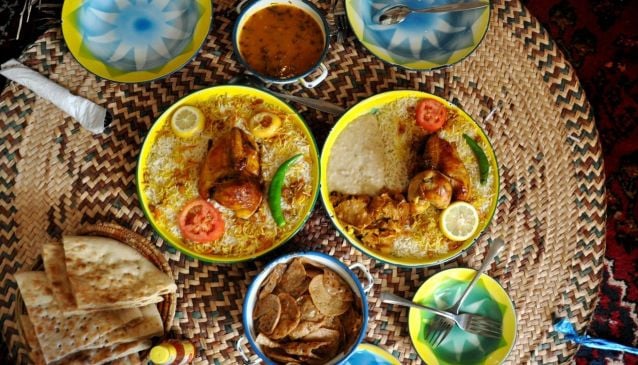Saudi Cuisine
Real tastes and genuine flavors can only be experienced in Saudi homes
Book Top Experiences and Tours in Saudi Arabia:
If youʻre booking your trip to Saudi Arabia last minute, we have you covered. Below are some of the top tours and experiences!- AlUla: Hegra, Dadan and Ikmah Highlights Tour
- Jeddah Airport (JED): Premium Lounge Access
- Riyadh: Full-Day City Tour with Hotel Pickup
- From AlUla: Hegra Tour
- Jeddah: Al-Balad Historical Highlights City Tour
Photo credit (above): Blue Abaya Photography
Saudi Arabia and ‘food’ in the same sentence always seem to lead to one word: the kabsa, a chicken or lamb and rice dish. And, despite the kabsa’s tasty virtues, many are hard pressed to name any other Saudi dish. (For those you who don’t know Arabic, there’s a pun in that line: kabsa comes from the verb ‘to press’).
But, as I’ve discovered, Saudi food is anything but that one dish or the adopted expat cuisine or the rows of imported fast food brands lining its main streets. A Saudi gastronomic experience is unique, eclectic and creatively flavorsome with culinary traditions rooted to the rich history of the Arabian Peninsula, its people and the multitude of ethnic groups that rode along the trade route.
First of all, a history lesson in spices: the people of the peninsula were quick to make use of the spices sold along the trade routes for purposes other than healing and fragrances. Like other peoples, the spices traded along the urban and desert routes in Arabia would soon find their way (crushed, roasted, ground or whole) into the diets of its indigenous people. Bedouins and townspeople alike took to cardamoms, cumin, saffron, pepper, ginger, turmeric, cloves and cinnamon to redefine their tastes and those of their descendants.
Spices enriched the traditional foods of the desert dwellers: meat, milk and dates. Rice and wheat, when available, was and continues to be a staple. The ever-present date, rich in calories, and cultivated in the desert oases, was the mainstay of nomadic tribes; today, the date and its many varieties grace all Saudi tables, both modern and traditional, every day of the week, every month of the year.
In the western province of Hejaz, with Mecca at its center, the impact of the early Hajj pilgrims on cooking traditions was long-lasting. The indigenous staples of dates, meat, milk and milk derivatives were doused with other exotic and imported ingredients.
Today, traditional foods such as ruz bukhari, a spicy cumin, rice, tomato, meat and carrot dish; harissa, meat with crushed sweetened wheat; and aysh bil lahm, bread coated with meat, leeks and sesame seed paste, are influences from afar but have long been adapted and integrated into the folklore of the province’s traditional foods.
Milky foods are a feature in Hejazi dishes. There’s saleeg, a meat, milk and rice dish spiced with cardamom and mistaka (mastic or Arabic gum), and lahuh, thin bread wafers topped with meat and yoghurt.
A breakfast dish, originally from the Hejaz, is shakshuka. These are eggs cooked with onions, tomatoes, cloves, and cumin.
Hejazi dessert delights are jubniya, sweetened goat’s cheese and masoub, bananas mashed and mixed with fried whole-wheat bread.
In the Najd province, the center of Saudi Arabia and its capital Riyadh, kharoof mahshi is the best known dish: baby lamb stuffed with rice, nuts, and raisins and coated with cloves, cardamom and cinnamon and ghee (samna) roasted on a spit.
Another Najdi favourite is mandi. Made with chicken and rice, the dish is smoked by placing pieces of coal inside an onion shell that sits on the rice. A lid on the dish ensures the smoke infuses the rice and chicken. Traditionally, of course, this dish would have been smoked in stoneware pots under the ground. The spice mix used in mandi is cardamom, cloves, pepper, ginger and bay leaves.
Matazeez, a lovely name for what is essentially another meat dish, is made with whole wheat pasta and loads of vegetables.
The Najd has ancient recipes: tharid, for example, is a dish with thin wafers of bread soaked with meat and broth. Today, it is supplemented with a healthy dose of vegetables.
Jarish, another Najdi dish, is made with wheat kernels that have been crushed, soaked and then turned into a creamy consistency, spiced with hot peppers and served with meat.
Salads are widely used in Saudi Arabia, the most common being a hot salad to complement a meat dish: the salata hara, made with tomatoes, coriander, lemon, chili peppers and baharat spices (a blend of pepper, coriander, cloves, cinnamon, cumin, cardamom and turmeric).
Much of this food, my local companion points out, is hard to find in commercial outlets. Local Saudi restaurants will offer some traditional dishes, "but the real tastes and genuine flavors, he adds, can only be experienced in Saudi homes."
Even then, it appears, sampling 'genuine' flavours is not always on the domestic menu. The advent of a large expat community has introduced new foods and many of the traditional Saudi foods are today prepared with different ingredients and through various methods by a creative and health-conscious younger generation. Mutton and beef, once a constant staple, have been replaced in many dishes by chicken or fish.
Other local Saudi foods fall under the generic title of Middle Eastern cuisine: falafel, chickpea fried balls; humus, a chickpea and tahini dip; fool, a fava bean dip (often spelt ‘foul’ but I prefer ‘fool’ as that’s the phonetic spelling); sayyadieh, fish cooked with rice browned with burnt onions; and sambousek, cheese or minced meat stuffed fried pastry.
But for an authentic and easily available Saudi experience, nothing beats gahwa and shai. Coffee and tea. Tea is brewed with either mint leaves or habak leaves (another type of mint herb). Saudi coffee is made with green Arabica coffee beans, and brewed with cardamom, cloves or alternatively saffron.
Coffee is an integral part of the local hospitality ritual. It’s a ritual that ensures no guest to a Saudi home or business is likely to leave without the nerve-soothing effects of cardamom or the mad rush of caffeine through their veins.













